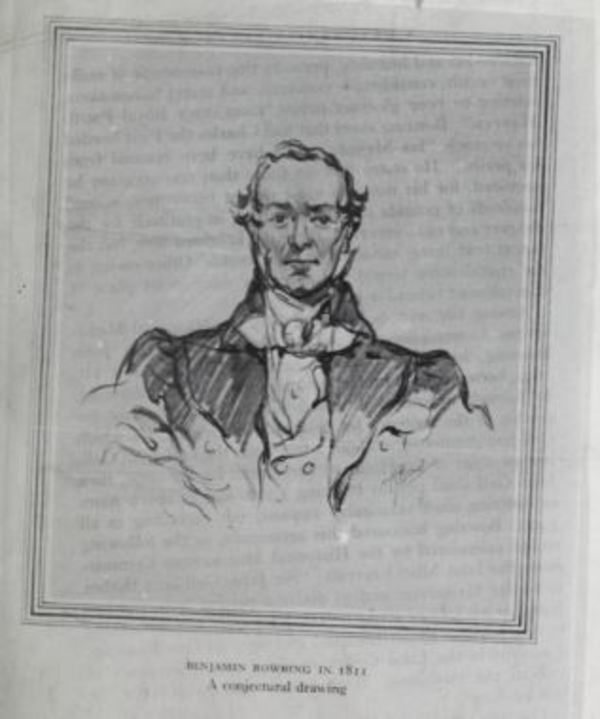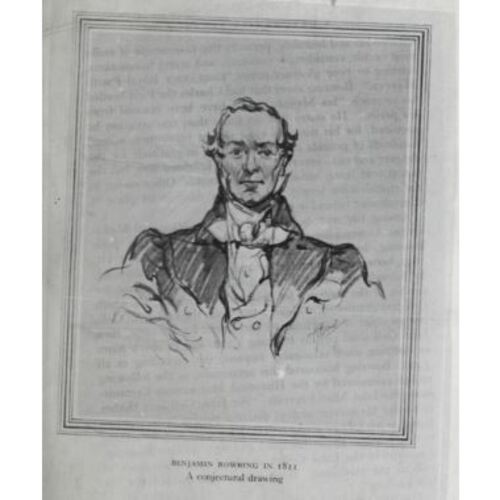
Source: Link
BOWRING, BENJAMIN, watchmaker and businessman; baptized 17 May 1778 in Exeter, England, one of three children of Nathaniel Bowring and Susannah White; m. 9 Oct. 1803 Charlotte Price in Wellington, Somerset, and they had five sons and one daughter; d. 1 June 1846 in Liverpool, England.
Benjamin Bowring came from a family that had been involved for over two centuries in the woollen industry in Exeter. After receiving his early education at the Unitarian chapel academy in his mother’s native Moretonhampstead, he apprenticed to watchmaker Charles Price, whose daughter he later married. Three days before his marriage, he opened his own watch-making shop in Exeter, and he built it into a prosperous business. A Nonconformist, Bowring was a strong supporter of the abolition of the slave trade and generally took an active role in Exeter’s social life.
Looking for new opportunities for his trade, in 1811 Bowring visited Newfoundland, which at the time was experiencing substantial growth in both its population and its fishery. No doubt his knowledge of the colony came from the long-standing connection of West Country merchants with the island’s fishery. During the Napoleonic Wars, St John’s was a booming frontier port whose population had increased from just over 3,200 in 1794 to approximately 10,000 in 1815.
Having made several trips to St John’s between 1811 and 1815, Bowring became one of the port’s permanent residents in 1815; the following spring his wife and family joined him. His early years in Newfoundland were marked by a depression in the fishery and by temporary set-backs when his watch-making shop was destroyed several times by fire during the period 1816–19. While he pursued his craft, his wife opened a small dry-goods store attached to the shop. Her business venture proved successful and Bowring decided to abandon watch-making to concentrate on what was a growing retail trade. He was able to establish himself firmly in the uncertain St John’s economy of the 1820s because of his family’s business connections in England through which he bought the necessary dry goods and manufactured products. During a poor fishery many merchants would fail, but Bowring was willing to take risks and this adventurous spirit was a decided asset to him. In 1823 he was secure and bold enough to purchase two schooners to transport goods from England and return with Newfoundland cod and seal products. The following year Bowring changed the name of his firm to Benjamin Bowring and Son when his eldest son, William, became a partner.
In addition to serving on the executives of several educational and charitable societies in St John’s in the early 1820s, Bowring was a strong advocate for the establishment of a municipal government to implement, among other measures, fire safety and building regulations. He and his fellow merchants believed that the existing system of government, whereby Newfoundland was administered by an imperially appointed governor, was inadequate to deal with the increasing political problems of both capital and colony. In 1826 an incorporation scheme for St John’s, of which Bowring was a prominent promoter, failed because of differences within the business community as to what form of taxation the proposed municipality should adopt. Following this failure, Bowring and other community leaders renewed their efforts to secure a colonial legislature for Newfoundland, which was finally instituted in 1832. However, his enthusiasm for the new legislature quickly waned after 1833 when politicians divided along religious lines and disputed issues of patronage [see William Carson]. Nevertheless, Bowring was pleased that one of the first acts of the House of Assembly in early 1833 was to provide for a compulsory fire brigade in St John’s.
This new attempt at fire protection proved no help when Bowring’s premises and much of the south side of Water Street were burnt on 7 July. The loss postponed for a year his decision to turn over the Newfoundland business to his son, Charles Tricks (William had drowned in 1828). It was Benjamin’s intention to build up a strong English side to the firm by providing the goods St John’s needed and marketing Newfoundland fishery products in England and Europe. As he still had sufficient capital to reestablish business in St John’s, he decided to do so. Once the premises were nearly completed in mid 1834, he gave control of the firm to Charles and with the rest of his family returned to England. In 1835 he set up a trading company, known as Benjamin Bowring, in Liverpool. Bowring remained in regular contact with his son, offering advice and examining the accounts of Benjamin Bowring and Son. Under Charles’s direction the company underwent substantial expansion during the 1830s and it entered the front ranks of the Water Street mercantile establishments. Crucial to its growth was the decision after 1834 to have the firm become directly involved in the lucrative seal fishery by providing its own vessels and building a storage vat at St John’s for the oil. The increased volume in business was a boost to the Liverpool company, whose financial and business transactions were closely tied to those of the Newfoundland enterprise. In 1839 the name of the latter firm was changed to Bowring Brothers when Charles’s brother Henry Price became his partner. Two years later they were joined by their brother Edward.
The association of Henry and Edward with the management of Bowring Brothers enabled Benjamin to turn over control of the Liverpool operation in 1841 to Charles, who none the less retained supervision of the Newfoundland company. Under Charles the Liverpool firm, renamed C. T. Bowring and Company, became a major international shipping and insurance business, while Bowring Brothers became one of the leading firms in the cod and seal fisheries and in the provision of foodstuffs and manufactured goods to Newfoundlanders (its expansion was continued under Charles’s son Charles R.*). Benjamin Bowring’s legacy is in the establishment of both businesses which, the St John’s Newfoundland Patriot wryly noted in 1839, were passed on to the “whole ‘tribe of Benjamin.’”
MHA, Bowring name file; Keith Matthews, “Profiles of Water Street merchants” (typescript, 1980). PRO, RG 4/965: 67. Melvin Baker, “The government of St. John’s, Newfoundland, 1800–1921” (phd thesis, Univ. of Western Ont., London, 1981). Gunn, Political hist. of Nfld. David Keir, The Bowring story (London, 1962). Paul O’Neill, The story of St. John’s, Newfoundland (2v., Erin, Ont., 1975–76), 2. A. C. Wardle, Benjamin Bowring and his descendants; a record of mercantile achievement (London, 1938).
Cite This Article
Melvin Baker, “BOWRING, BENJAMIN,” in Dictionary of Canadian Biography, vol. 7, University of Toronto/Université Laval, 2003–, accessed December 14, 2025, https://www.biographi.ca/en/bio/bowring_benjamin_7E.html.
The citation above shows the format for footnotes and endnotes according to the Chicago manual of style (16th edition). Information to be used in other citation formats:
| Permalink: | https://www.biographi.ca/en/bio/bowring_benjamin_7E.html |
| Author of Article: | Melvin Baker |
| Title of Article: | BOWRING, BENJAMIN |
| Publication Name: | Dictionary of Canadian Biography, vol. 7 |
| Publisher: | University of Toronto/Université Laval |
| Year of publication: | 1988 |
| Year of revision: | 1988 |
| Access Date: | December 14, 2025 |



